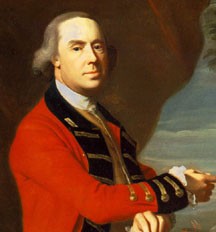Thomas Gage (1721-1787) was a general who served as the commander of military forces in North America and the military governor of Massachusetts after the passing of the Coercive Acts.
Born in Sussex, Gage was the son of an Irish viscount. A mediocre student, he opted for a military career and exploited his family’s connections to obtain a lieutenant’s commission (1741). Gage served in the French and Indian War under General Braddock, and by 1758 had reached the rank of brigadier general.
In 1760 Gage was appointed governor of Montreal. Three years later he became commander in chief of British forces in North America, replacing General Amherst. He held this role continuously for 10 years.
Gage returned to England briefly but by mid-1774 he was back in America, posted to New York to oversee the enforcement of the Coercive Acts. In May 1774, Gage was appointed governor of Massachusetts, replacing the unpopular Thomas Hutchinson, who had sought indefinite leave.
Gage, who was mild-mannered and respected by Americans for his service during the French and Indian War, was a popular appointment with Loyalists, moderates and even some revolutionaries. Despite this, he was committed to implementing British policy and following the instructions of the Colonial Office.
In late summer 1774, Gage began seizing stores of gunpowder in and around Boston, to prevent it falling into the hands of local militias. This action instigated the ‘Powder Alarms’ of late 1774. Gage became a figure of derision, to the extent where his effigy was publicly burned in November that year.
In April 1775, Gage, acting on instructions from London, sent a military expedition to disarm rebels in Lexington. The Battle of Lexington led to calls for Gage’s removal and he was withdrawn to England in October.
Content on this page is © Alpha History 2018-23. Content created by Alpha History may not be copied, republished or redistributed without our express permission. For more information please refer to our Terms of Use.

